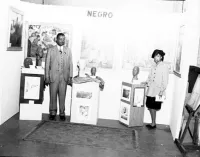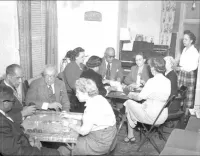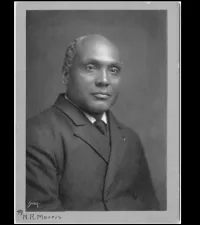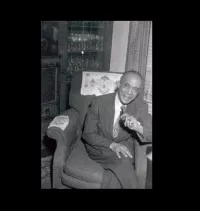Share what you know,
and discover more.
Share what you know,
and discover more.
Jun 01, 1959
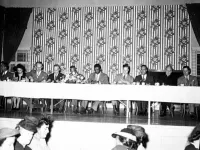
-

- Charmaine Bantugan
401 Selby Avenue, Saint Paul, MN, USA
Urban League Building By CultureBrokers Foundation, Inc. 2008. “Points of Entry: The African American Heritage Guide to Saint Paul. The first employment services for African Americans seeking entry into the local workforce were delivered out of barbershops and beauty parlors. Most important of these was the Hall Brothers Barbershop. S. Edward and O.C. Hall serviced white politicians and business leaders. Using these connections, the Hall Brothers posted jobs and personally referred many individuals to prospective employers. Churches began providing a more organized resource for locating jobs and housing through newsletters like St. James A.M.E.’s “The Helper.” In 1887, the Minnesota Protective and Industrial League and later the Afro American League played pivotal roles in improving the economic condition of blacks Out of a confluence of local activities and a national black agenda emerged the Urban League of Saint Paul, founded in 1923 with the help of barber S. Edward Hall. Interestingly, the local white business association objected to the formation of this branch fearing that it would encourage more black migration to Minnesota. Cite this Page CultureBrokers Foundation, Inc. 2008. "Points of Entry: The African American Heritage Guide to Saint Paul.", “Urban League Building,” Saint Paul Historical, accessed June 24, 2022, https://saintpaulhistorical.com/items/show/262.
401 Selby Avenue, Saint Paul, MN, USA
Urban League Building By CultureBrokers Foundation, Inc. 2008. “Points of Entry: The African American Heritage Guide to Saint Paul. The first employment services for African Americans seeking entry into the local workforce were delivered out of barbershops and beauty parlors. Most important of these was the Hall Brothers Barbershop. S. Edward and O.C. Hall serviced white politicians and business leaders. Using these connections, the Hall Brothers posted jobs and personally referred many individuals to prospective employers. Churches began providing a more organized resource for locating jobs and housing through newsletters like St. James A.M.E.’s “The Helper.” In 1887, the Minnesota Protective and Industrial League and later the Afro American League played pivotal roles in improving the economic condition of blacks Out of a confluence of local activities and a national black agenda emerged the Urban League of Saint Paul, founded in 1923 with the help of barber S. Edward Hall. Interestingly, the local white business association objected to the formation of this branch fearing that it would encourage more black migration to Minnesota. Cite this Page CultureBrokers Foundation, Inc. 2008. "Points of Entry: The African American Heritage Guide to Saint Paul.", “Urban League Building,” Saint Paul Historical, accessed June 24, 2022, https://saintpaulhistorical.com/items/show/262.
Jun 01, 1959
401 Selby Avenue, Saint Paul, MN, USA
Urban League BuildingBy CultureBrokers Foundation, Inc. 2008. “Points of Entry: The African American Heritage Guide to Saint Paul.
The first employment services for African Americans seeking entry into the local workforce were delivered out of barbershops and beauty parlors. Most important of these was the Hall Brothers Barbershop. S. Edward and O.C. Hall serviced white politicians and business leaders. Using these connections, the Hall Brothers posted jobs and personally referred many individuals to prospective employers. Churches began providing a more organized resource for locating jobs and housing through newsletters like St. James A.M.E.’s “The Helper.”
In 1887, the Minnesota Protective and Industrial League and later the Afro American League played pivotal roles in improving the economic condition of blacks Out of a confluence of local activities and a national black agenda emerged the Urban League of Saint Paul, founded in 1923 with the help of barber S. Edward Hall. Interestingly, the local white business association objected to the formation of this branch fearing that it would encourage more black migration to Minnesota.
Cite this Page
CultureBrokers Foundation, Inc. 2008. "Points of Entry: The African American Heritage Guide to Saint Paul.", “Urban League Building,” Saint Paul Historical, accessed June 24, 2022, https://saintpaulhistorical.com/items/show/262.
Posted Date
Jun 23, 2022
Historical Record Date
Jun 01, 1959
Source Name
Saint Paul Historical
Source Website
Delete Story
Are you sure you want to delete this story?


